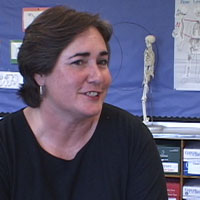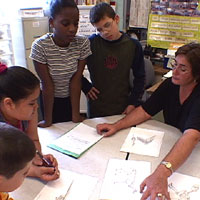Join us for conversations that inspire, recognize, and encourage innovation and best practices in the education profession.
Available on Apple Podcasts, Spotify, Google Podcasts, and more.
 “My fifth graders start out with a lot of natural curiosity about life science. I think even on the walk home, kids are looking at animals or noticing changes in the seasons. And it’s the curiosity, some of the magic: “Well, why did the leaves change?” So I think the natural interest is there, and all you have to do is bring it up and then really get them to focus on using their scientific skills.”
“My fifth graders start out with a lot of natural curiosity about life science. I think even on the walk home, kids are looking at animals or noticing changes in the seasons. And it’s the curiosity, some of the magic: “Well, why did the leaves change?” So I think the natural interest is there, and all you have to do is bring it up and then really get them to focus on using their scientific skills.”
Gail Modugno teaches fifth-grade math and science at the Alice B. Beal Elementary School in Springfield, MA, the largest city in the state west of Boston. It is a diverse school system, and the school’s enrollment breaks down into nearly perfect thirds between black, Hispanic, and white students. In all areas of state testing, the school’s students score at or above state averages; about 65% of the school’s 312 students receive a free or reduced-price lunch.
The Beal School recently changed its format for fifth grade, assigning its teachers to focus on two subjects and splitting the class into two groups: in the morning, half have math and science while the other half study language arts and social studies, and in the afternoon, they switch.
“When I came into teaching, I was surprised that I fell towards the math and science,” said Gail. “I never expected to, but over the years, that’s just the direction I went in.” When the school made the decision to split the grade and the teaching responsibilities, Gail requested the math and science section, and she now teaches those subjects to all sixty of the school’s fifth graders.
 Lesson at a Glance:
Lesson at a Glance:
Curriculum: Insights, Education Development Center, Inc., Kendall/Hunt Publishing Company
Grade: Fifth
Topic: Comparing Animal Skeletons
Prior to the activity in Session 6, Gail’s class was studying similarities and differences in animal skeletons. At the beginning of the unit, the class dissected a “mystery object” – an owl pellet. Inside, the students found what they were sure were a variety of bones, but they were unsure what the bones did, much less which animal they belonged to. Gail had them put aside the pellet, while the class spent a number of days studying the human skeleton. Her goal was for her students to gain the skills they would need to identify the bones in the pellet, and, most important, for them to understand that all bones can be divided into six groups, with each group performing a separate function. Then her class went back to the owl pellets and sorted those bones based on what they had learned.
The class also spent time looking at different mammal skulls and at the various features of omnivores, herbivores, and carnivores. The goal here was to tie form to function, to get her students to look at the different parts of the skulls – teeth, jaw, cranium – of various animals and to think about why they were the way they were.
For the activity featured in the video, groups of students observed two pictures of skeletons and discussed the similarities and differences between them. Then the whole class discussed their observations. The activity was intended to get Gail’s students to consider the similarities between different animals and to think about the possibility of relatedness between them – could they have a common ancestor? What might it have looked like?
 Lesson Goals:
Lesson Goals:
Students identify the extent to which different animals are similar.
Students consider how similarities might reflect relatedness among animals.
Students generate descriptions of a common ancestor for different animals.
Consider the goals for this lesson as listed above. How can you create a lesson appropriate for your classroom that will fulfill similar goals?